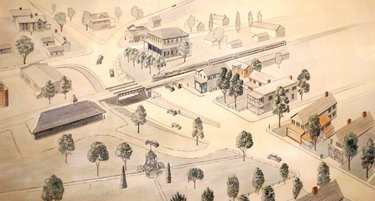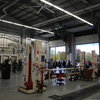Long railroad waits are already here
VOORHEESVILLE — Local village residents who’ve driven recently on Main Street and Voorheesville Avenue in the village may have gotten a preview of what it’s going to be like waiting for a very long train to pass through Altamont and Voorheesville.
On May 11, the evening of a recent village of Voorheesville trustee workshop, starting at about 7:25 p.m., at the Main Street crossing, an Enterprise reporter waited for 18.5 minutes as a CSX train traveling at about 5 miles per hour pulled somewhere in the vicinity of between 140 and 160 railcars through the village.
While the existing CSX tracks over Main Street and Voorheesville Avenue are technically part of the broader proposal approved by federal regulators in April that will allow Norfolk Southern to operate a 9,000-foot-long specialty train twice a day between the Voorheesville and central Massachusetts, it’s not the specific 15.5 miles of line that run from Voorheesville, through Altamont, ending in Delanson where it will connect to Norfolk Southern’s line running east toward Schenectady and Saratoga counties and westbound for Chicago.
The major track work is anticipated to start sometime in the early fall, Norfolk Southern previously told The Enterprise.
Mayor Rich Straut told The Enterprise on May 24 that he was told by CSX the company would be operating fewer trains per day but still running the same amount of freight on its lines, which means the carrier would either be double-stacking its cargo or operating longer trains.
“I don’t remember back seven, eight years ago, how long [the trains] were, or whether they were double stacked,” Straut said. “But I guess the only way to get the same amount of freight is [longer trains or stacking it].”
Starting in 2017, with CSX at the vanguard, the nation’s Class I freight carriers, defined as companies earning revenue greater than $900 million (there are currently seven), began implementing a new management system, known as “precision-scheduled railroading,” or PSR.
PSR sought to teach an old dog new and well-tried tricks.
When implemented, PSR paid off huge for investors because the new system constituted little more than laying off nearly a third of workers, neglecting capital expenditures, and operating much longer trains. A 2019 study from the Government Accountability Office found average train length had increased by 25 percent over the previous decade.
Early 2017 investor material shows CSX train lengths of about 6,300, increasing to approximately 7,250 feet a year later. The company stopped stating specific lengths in its quarterly calls with analysts, choosing instead to offer year-over-year update increases, like in the fourth quarter of 2020 when CSX train length increased by 19 percent compared to the year prior.
In recent Teamster testimony submitted to the Surface Transportation Board on urgent issues in freight rail service, the union included a list of the longest trains on CSX’s rails during the first quarter of 2022. Of the 10 longest trains operated by CSX during the first three months of his year, two had New York State departure locations including the carrier’s longest, a 377-car 4.57-mile-long behemoth that departed Schenectady and headed west for Indiana.
On May 24, Straut said he was leaving Village Hall a few days prior to the meeting and encountered the train for himself. “I’ve never seen a train go that slow in my 20 years [as a village resident],” he said. It was going five miles per hour.
The most recent Federal Railroad Administration data, from December 2020, showed 35 trains a day traveled through the crossings at Voorheesville Avenue with a maximum speed of 50 miles per hour with a typical speed range between 5 and 50 miles per hour.
The annual average daily traffic count passing over the Voorheesville tracks, based on numbers from 2014, was 2,575 vehicles a day, with 24 of those vehicles being school buses, and 6 percent being trucks, according to the FRA.
The next available year for freight traffic was 2018, when 37 daily trains passed over Voorheesville Avenue. Over the course of two decades, the number of daily train trips through the village gradually declined by half, from 76 in 2001 to 35 in December 2020.
Though technically connected to the earlier deal that brought Voorheesville to the table with CSX and Norfolk Southern and allowed the village to voice its concerns over the safety issues posed by the deal, CSX’s running of a nearly-20-minute train over Main Street and Voorheesville Avenue presents similar safety issues for trustees.
“We have not heard anything from them,” Straut said during the May 24 meeting when asked about the train. “But we will be following up because that one train was a concern. I mean, it’s pretty unusual. I’ve never seen it.”
Deputy Mayor Richard Berger pointed out that, if emergency crews were cut off by a train, they know they can use Maple Avenue, which dips under CSX’s line, and then use Pine Street to get to the other side of the tracks.
The Enterprise sent specific questions to CSX related to its train running through Voorheesville, and received 116 words of corporate jargon in response. So for now, it remains unclear if some drivers stopped at the Voorheesville Avenue and Main Street railroad crossings will be waiting for nearly 20 minutes or if there will be a return to previous wait times.
Altamont
In Altamont, there is no way to bypass the Main Street railroad crossing.
In January, Altamont sent a letter to the regulator overseeing CSX’s recent acquisition of the Massachusetts-based Pan Am Railways asking the Surface Transportation Board to reject the deal because the “negative consequences to the safety and wellbeing of the community cannot be understated and could result in loss of life and property under a worst-case scenario.”
In the Jan. 5 letter, village attorney Allyson Phillips wrote that Altamont opposed the deal because running a 1.7-mile-long train twice per day over Main Street would leave parts of the village inaccessible to emergency responders for as long as 10 minutes.
The most recent Federal Railroad Administration data, from June 2019, showed two trains a day traveled over Altamont’s Main Street at a maximum speed of 10 miles per hour with a typical speed range between 5 and 10 miles per hour — however, the FRA inventory goes back to 1977, which shows the maximum timetable speed prior to 1998 was 35 miles per hour.
The speed of Norfolk Southern’s train is not yet known. For the last month, the average speed for a train on its system has been about 17 miles per hour, about a mile per hour below Norfolk Southern’s year-to-date average, according to industry data filed with the STB. But still well below each of the last three years, when the company ended 2021, 2020, and 2019 with average speeds of 20.2 miles per hour, 23.2 miles per hour, and 22.3 miles per hour, respectively.
The average speed of trains pulling Norfolk Southern’s specialized rail cars for transporting automobiles, which are what’s proposed for the 15.5 former Voorheesville Running Track, chugged along at a slower speed than the system-wide average, about a mile per hour below in each of the previous examples.
The four decades of FRA records, with the caveat that a number of years are missing, showed just twice — 1977 and 1985 — did more than two trains, in both cases, just three, pass over Main Street in Altamont.
The annual average daily traffic count, based on numbers from 2014, was 6,513 cars a day passing over the tracks, with an estimated 5 percent trucks. The FRA data says the Main Street Crossing is not regularly used by school buses and is not an emergency services route, both of which are incorrect.
According to the Guilderland Central School District supervisor of transportation, Inho Suh, approximately 30 buses per school day travel over Altamont’s Main Street.
In response to an Enterprise question about her communication with Norfolk Southern, Altamont Mayor Kerry Dineen wrote in part, “We have been talking with railroad representatives over the last year and met specifically with members of the Surface Transportation Board, prior to the merger, to express our concerns about the delay these trains will create for emergency medical services as we have no bypass, and the danger then created for both Village and Town residents.”
Dineen continued, “I requested a train schedule so dispatch would be aware and prepared when emergency calls come in, however, I was told that a schedule was not available.”
The mayor said the village will continue to engage in talks with CSX in addition to local and federal elected officials representing Altamont.


